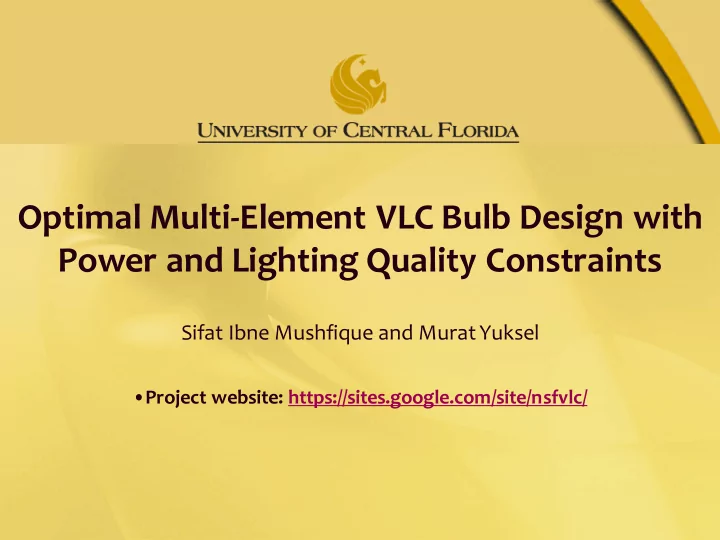

Optimal Multi-Element VLC Bulb Design with Power and Lighting Quality Constraints Sifat Ibne Mushfique and Murat Yuksel • Project website: https://sites.google.com/site/nsfvlc/
Why Multi-Element/Stream VLC? LED Array • Unused space Photo- detector Single data stream Multiple data streams PHY solution Narrow divergence – for higher spatial reuse Large divergence – for smooth Spherical structures – to retain smooth lighting lighting VLCS 2016 2
Problem Statement Ø Introduce an framework of a Multi-element Bulb Design that – • Optimizes the placement of LED boards/transmitters - Maximizing the signal-to-interference ratio (SIR) - Maintain a minimum evenness of the lighting on the room floor • Also, explores the optimization characteristics - Under various constraints Ø Challenges of a Multi-element Bulb Design • Handle the line-of-sight (LOS) alignment management • Implement seamless communication across the room • Resolve inter-LED interference • Balance the tradeoff: uniform lighting and high spatial reuse VLCS 2016 3
Multi-element Bulb Configuration VLCS 2016 4
System Model VLCS 2016 5
Optimization Objective Maximize SIR For a particular number of layers Add divergence angle to the optimization problem Make the problem constrained with Power Update the problem with the constraint on the illumination quality Two results are compared to analyze the effect of the illumination requirement on the overall optimization problem VLCS 2016 6
Maximum SIR Problem (MAX_SIR) Ø Variable Parameters • k i , Number of Transmitters in Layer i - LED boards can be placed in layers in many different ways - k i depends on the size of the LED boards ( r t ) and the Bulb radius ( R ) • θ d , Divergence Angle of LEDs - Large divergence angles à better lighting - Narrow divergence angles à increased spatial reuse & higher SIR - Different divergence angles are tried to find the configurations yielding maximum SIR VLCS 2016 7
Placement of the Transmitters 295 290 R 290 285 285 280 280 275 275 270 Layers 270 265 265 260 40 260 40 20 20 0 0 40 30 -20 20 10 0 -20 -10 -20 40 -40 30 -30 20 -40 10 0 -40 -10 -20 -30 -40 R = 40 cm, r t = 3.5 cm R = 40 cm, r t = 5.5 cm No. of Layers = 7 No. of Layers = 4 VLCS 2016 8
Maximum SIR Problem (Contd.) Ø Fixed Parameters • Room size - 6m x 6m x 3m • R , Radius of the Hemispherical Bulb – 40 cm • r t , Radius of the LED Board/Transmitter - 3.5cm • l , Number of Layers - Depending on R and r t - Minimum number of layers à 2 - Maximum number of layers à calculated from R and r t - The number of Layers and LED boards is varied between this minimum and maximum value VLCS 2016 9
Non-Linearity of the Objective Function Local Minima Local Maxima SIR doesn’t increase linearly 6 20 degree 25 degree 5.5 7 30 degree 6 5 Avg. SIR (dB) Avg. SIR (dB) 5 4.5 4 4 3 3.5 2 40 35 8 3 30 6 25 4 2.5 20 Divergence 2 2 3 4 5 6 7 No. of layers angles No. of layers Multiple Local Maxima Saturation of the SIR Value and Minima VLCS 2016 10
Updating the Maximum SIR Problem (MAX_SIR_LQ) • Illumination Constraint (I s ) is added to obtain smooth lighting • I s is calculated by continuously taking average luminous intensity of 100 random points until the valueconverges • Maximum allowed illumination variance, I smax = 5 • The new objective function output is then (SIR / I s ) instead of SIR VLCS 2016 11
Results Objective l (number of layers) k 1 k 2 k 3 θ d (in degrees) 2 19 2 -- 39.5 MAX_SIR 3 16 26 2 47.2 MAX_SIR_LQ 2 6 28 -- 16 • MAX_SIR has much fewer LEDs in the higher layer • MAX_SIR_LQ puts more LEDs in the higher layer to achieve more even lighting across the room VLCS 2016 12
Results (Contd.) Illumination variance (Is) SIR without illumination constraint 2 8 SIR value SIR with illumination constraint saturates Illumination variance (Is) 1.8 6 Avg. SIR (dB) 1.6 4 Lighting Quality 1.4 2 starts to deteriorate as I s increases 1.2 0 Optimum SIR is 2 4 6 8 10 Power Constraint (Watts) significantly lower in MAX_SIR_LQ Objective function output (Avg. SIR / Is) 2 (SIR / I s ) starts to fall 1.9 from the same time 1.8 1.7 1.6 1.5 1.4 1.3 1.2 2 4 6 8 10 Power Consraint (Watts) VLCS 2016 13
Summary and Future Work • A framework is introduced to optimize a multi-element bulb design for both illumination and communication quality of VLC in a room • In the future, this can be done for different room size and bulb parameters • Trying with bulbs of some other shapes (Triangular, Square etc.) can be interesting • Multiple number of bulbs can be considered as well VLCS 2016 14
QUESTIONS?
Recommend
More recommend